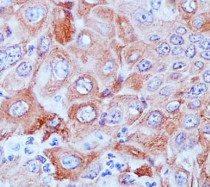ARG57583
anti-GM130 antibody
anti-GM130 antibody for ICC/IF,IHC-Formalin-fixed paraffin-embedded sections,Immunoprecipitation,Western blot and Human,Mouse,Rat,Cow,Dog,Monkey
Overview
| Product Description | Rabbit Polyclonal antibody recognizes GM130 |
|---|---|
| Tested Reactivity | Hu, Ms, Rat, Cow, Dog, Mk |
| Tested Application | ICC/IF, IHC-P, IP, WB |
| Host | Rabbit |
| Clonality | Polyclonal |
| Isotype | IgG |
| Target Name | GM130 |
| Antigen Species | Human |
| Immunogen | Synthetic peptide from Human GM130. |
| Conjugation | Un-conjugated |
| Alternate Names | 130 kDa cis-Golgi matrix protein; Golgin subfamily A member 2; GM130 autoantigen; GM130; Golgin-95 |
Application Instructions
| Application Suggestion |
|
||||||||||
|---|---|---|---|---|---|---|---|---|---|---|---|
| Application Note | * The dilutions indicate recommended starting dilutions and the optimal dilutions or concentrations should be determined by the scientist. | ||||||||||
| Observed Size | ~130 kDa |
Properties
| Form | Liquid |
|---|---|
| Purification | Affinity purified. |
| Buffer | PBS (pH 7.4), 150mM NaCl, 0.02% Sodium azide and 50% Glycerol. |
| Preservative | 0.02% Sodium azide |
| Stabilizer | 50% Glycerol |
| Storage Instruction | For continuous use, store undiluted antibody at 2-8°C for up to a week. For long-term storage, aliquot and store at -20°C. Storage in frost free freezers is not recommended. Avoid repeated freeze/thaw cycles. Suggest spin the vial prior to opening. The antibody solution should be gently mixed before use. |
| Note | For laboratory research only, not for drug, diagnostic or other use. |
Bioinformation
| Database Links | |
|---|---|
| Gene Symbol | GOLGA2 |
| Gene Full Name | golgin A2 |
| Background | GM130: The Golgi apparatus, which participates in glycosylation and transport of proteins and lipids in the secretory pathway, consists of a series of stacked cisternae (flattened membrane sacs). Interactions between the Golgi and microtubules are thought to be important for the reorganization of the Golgi after it fragments during mitosis. This gene encodes one of the golgins, a family of proteins localized to the Golgi. This encoded protein has been postulated to play roles in the stacking of Golgi cisternae and in vesicular transport. Several alternatively spliced transcript variants of this gene have been described, but the full-length nature of these variants has not been determined. [provided by RefSeq, Feb 2010] |
| Function | GM130: Peripheral membrane component of the cis-Golgi stack that acts as a membrane skeleton that maintains the structure of the Golgi apparatus, and as a vesicle thether that facilitates vesicle fusion to the Golgi membrane (Probable) (PubMed:16489344). Required for normal protein transport from the endoplasmic reticulum to the Golgi apparatus and the cell membrane. Together with p115/USO1 and STX5, involved in vesicle tethering and fusion at the cis-Golgi membrane to maintain the stacked and inter-connected structure of the Golgi apparatus. Plays a central role in mitotic Golgi disassembly: phosphorylation at Ser-37 by CDK1 at the onset of mitosis inhibits the interaction with p115/USO1, preventing tethering of COPI vesicles and thereby inhibiting transport through the Golgi apparatus during mitosis. Also plays a key role in spindle pole assembly and centrosome organization (PubMed:26165940). Promotes the mitotic spindle pole assembly by activating the spindle assembly factor TPX2 to nucleate microtubules around the Golgi and capture them to couple mitotic membranes to the spindle: upon phosphorylation at the onset of mitosis, GOLGA2 interacts with importin-alpha via the nuclear localization signal region, leading to recruit importin-alpha to the Golgi membranes and liberate the spindle assembly factor TPX2 from importin-alpha. TPX2 then activates AURKA kinase and stimulates local microtubule nucleation. Upon filament assembly, nascent microtubules are further captured by GOLGA2, thus linking Golgi membranes to the spindle (PubMed:19242490, PubMed:26165940). Regulates the meiotic spindle pole assembly, probably via the same mechanism. Also regulates the centrosome organization (PubMed:18045989, PubMed:19109421). Also required for the Golgi ribbon formation and glycosylation of membrane and secretory proteins (PubMed:16489344, PubMed:17314401). [UniProt] |
| Cellular Localization | cis-Golgi network membrane; Peripheral membrane protein Note: Peripheral membrane protein associated with cis-Golgi stacks (By similarity). Associates with the mitotic spindle during mitosis (PubMed:26165940). [UniProt] |
| Calculated MW | 113 kDa |
| PTM | Cleaved by caspases at the onset of apoptosis. Methylation by PRMT5 is required for Golgi ribbon formation. While dimethylation at Arg-30 and Arg-35 are confirmed in vivo, it is unclear whether Arg-18 is methylated in vivo. Phosphorylated at Ser-37 by CDK1 at the onset of mitosis, inhibiting the interaction with p115/USO1 and triggering Golgi disassembly (PubMed:20421892, PubMed:26165940). Phosphorylated at Ser-37 in prophase as the Golgi complex starts to break down, and remains phosphorylated during further breakdown and partitioning of the Golgi fragments in metaphase and anaphase. In telophase, GM130 is dephosphorylated by PP2A as the Golgi fragments start to reassemble (By similarity). [UniProt] |
Images (2) Click the Picture to Zoom In
Specific References









